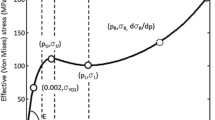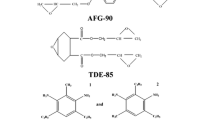Abstract
The temperature dependence of the failure stress of RTM6 resin under nearly pure hydrostatic tension was measured for two standard curing cycles. The stress in the resin was achieved by confining the resin in capped quartz tubes while cooling from the curing temperature. The stress was estimated from the deflection of the outer wall of the quartz tube relative to its unstressed diameter assuming linear elasticity. The failure stress increased monotonically on cooling from the curing temperature and reached a maximum value of 28 MPa at 108 °C. This value is roughly consistent with the failure stress estimated from a void initiation failure criterion using room temperature tensile strength.







Similar content being viewed by others
References
Tsukrov I, Bayraktar H, Giovinazzo M, Goering J, Gross T, Fruscello M et al (2011) Finite element modeling to predict cure-induced microcracking in three-dimensional woven composites. Int J Fract 172:209–216. doi:10.1007/s10704-011-9659-x
Asp LE, Berglund LA, Talreja R (1996) A criterion for crack initiation in glassy polymers subjected to a composite-like stress state. Compos Sci Technol 56:1291–1301
Fiedler B, Hojo M, Ochiai S, Schulte K, Ando M (2001) Failure behavior of an epoxy matrix under different kinds of static loading. Compos Sci Technol 61:1615–1624. doi:10.1016/S0266-3538(01)00057-4
Hobbiebrunken T, Hojo M, Fiedler B, Tanaka M, Ochiai S, Schulte K (2004) Thermomechanical analysis of micromechanical formation of residual stresses and initial matrix failure in CFRP. JSME Int J Ser A 47:349–356
Gent AN, Lindley PB (1959) Internal rupture of bonded rubber cylinders in tension. Proc R Soc Lond A Math Phys Sci 249:195–205
Lindsey GH (1967) Triaxial fracture studies. J Appl Phys 38:4843. doi:10.1063/1.1709232
Asp LE, Berglund LA, Gudmundson P (1995) Effects of a composite-like stress state on the fracture of epoxies. Compos Sci Technol 53:27–37. doi:10.1016/0266-3538(94)00075-1
Kim JW, Medvedev G, Caruthers JM (2013) Observation of yield in triaxial deformation of glassy polymers. Polymer (Guildf) 54:2821–2833. doi:10.1016/j.polymer.2013.03.042
Plepys A, Vratsanos MS, Farris RJ (1994) Determination of residual stresses using incremental linear elasticity. Compos Struct 27:51–56. doi:10.1016/0263-8223(94)90066-3
Plepys AR, Farris RJ (1990) Evolution of residual stresses in three-dimensionally constrained epoxy resins. Polymer (Guildf) 31:1932–1936. doi:10.1016/0032-3861(90)90019-U
Munro R G (2002) (NIST). Elastic moduli data for polycrystalline ceramics. NIST Interag Intern Rep 6853
Kachanov M, Shafiro B, Tsukrov I (2003) Handbook of elasticity solutions. Springer, Netherlands
Brauner C, Block TB, Purol H, Herrmann AS (2012) Microlevel manufacturing process simulation of carbon fiber/epoxy composites to analyze the effect of chemical and thermal induced residual stresses. J Compos Mater 46:2123–2143. doi:10.1177/0021998311430157
Fiedler B, Hobbiebrunken T, Hojo M, Schulte K (2005) Influence of stress state and temperature on the strength of epoxy resins. 11th Int Conf Fract 2005, ICF11; 3:2271–2275
Gross T, Jafari H, Tsukrov I, Bayraktar H, Goering J (2016) Curing cycle modification for RTM6 to reduce hydrostatic residual tensile stress in 3D woven composites. J Appl Polym Sci. doi:10.1002/APP.43373
Acknowledgements
This work was performed in partial fulfillment of the M.S. degree requirements for authors Jordan Kusch and Hesam Jafari. The work was supported by National Science Foundation grant CMMI-1100409, the New Hampshire Innovation Research Center, and by Albany Engineered Composites. This publication was motivated by the activities of the NIST funded Advanced Manufacturing Technology Consortium “Facilitating Industry By Engineering, Roadmapping, and Science” (FIBERS).
Author information
Authors and Affiliations
Corresponding author
Electronic supplementary material
Below is the link to the electronic supplementary material.
ESM 1
(PDF 270 kb)
Rights and permissions
About this article
Cite this article
Gross, T.S., Jafari, H., Kusch, J. et al. Measuring Failure Stress of RTM6 Epoxy Resin under Purely Hydrostatic Tensile Stress using Constrained Tube Method. Exp Tech 41, 45–50 (2017). https://doi.org/10.1007/s40799-016-0153-2
Received:
Accepted:
Published:
Issue Date:
DOI: https://doi.org/10.1007/s40799-016-0153-2




